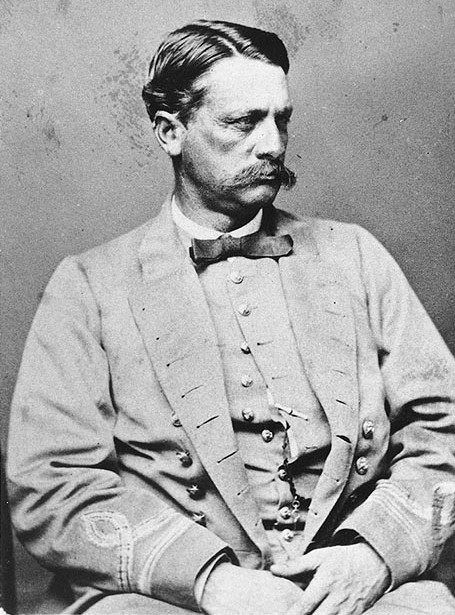Commander James Iredell Waddell CSN |
|
(1824-1886) |
 |
Commander James Iredell Waddell |
James Iredell Waddell-born on 13 July 1824 in Pittsboro, N.C.-was appointed a midshipman on 10 September 1841-and began serving in ship-of-the-line Pennsylvania the following December. During the Mexican War, he took part in the blockade at Vera Cruz while assigned to the brig Somers; and he subsequently saw sea duty along the coast of South America in sloop-of-war Germantown and completed a tour of duty as an instructor at the Naval Academy. In July 1859, he reported on board Saginaw and later returned from a tour of duty in the Orient with the East Indies Squadron, in John Adams, shortly after the outbreak of the Civil War. As his sympathies lay with the Southern States, he resigned his commission in the Navy, and his name was struck from the Navy rolls on 18 January 1862. Waddell secretly entered the service of the Confederacy by way of Baltimore, Md., and received an appointment as lieutenant in the Confederate States Navy on 27 May 1862. The Confederate Navy, however, had few ships to which these officers could be assigned. Naval officers were, as a result, assigned to artillery units. Thus employed, Waddell participated in the attempt to stop the Federal Fleet from investing New Orleans; helped man a gun battery in repulsing the Union flotilla in the Battle of Drewry's Bluff, Va., and performed nearly identical service manning a gun battery in the defense of Charleston, S.C., until March of 1863. At that time, he sailed for France in a steamer acquired by Confederate naval agent James D. Bulloch. On 19 October 1864, near Funchal, Madeira, Waddell took command of an iron-hulled screw steamer- Sea King -a Clyde-built merchantman which had earlier sailed, ostensibly, for Bombay, India, on a trading voyage. It was off Madeira, however, that Sea King under went the transformation from merchantman to man- of-war. Fitted out secretly, Sea King was armed and renamed Shenandoah, and set course for the Pacific. Under orders to concentrate on the previously unmolested Union whaling fleet in the Pacific, Shenandoah put five ships to the torch en route to the Cape of Good Hope, and bonded a sixth to carry prisoners to Bahia, Brazil. Proceeding through the Indian Ocean, Waddell paused at Melbourne, Australia, long enough to repair a defective propeller shaft in January 1865 and enlist the aid of 42 "stowaways" who appeared on deck soon after departure to swell the ranks of what had previously been an under-strength crew. Shenandoah captured four Yankee whalers en route to the Sea of Okhotsk, and later operated in the Bering Sea-capturing two dozen prizes between 21 and 29 June. One of the latter prizes carried a choice find- relatively recent newspapers. But the news which the Southerners read was not good-General Robert E. Lee had surrendered at Appomattox Court House, Va., while President Jefferson Davis had issued his defiant "Danville Proclamation" calling for a continued vigorous prosecution of the war against the Union forces. Waddell and his crew sighted no additional sails until 2 August 1865, when his ship fell in with British merchantman Barracouta. The Briton informed Shenandoah that the Confederacy had completely collapsed and that Shenandoah was thus no longer a man-of-war, but a "pirate" ship without a country. This made the erstwhile raider subject to seizure under international law. A thousand miles west of Acapulco, Mex., and 13 days from San Francisco, Calif., Waddell disregarded advice to beach his ship or sail to the nearest British colonial port where his men would be forced to shift for themselves. Subsequently, courage and seamanship brought Shenandoah through a remarkable 17,000-mile voyage, via Cape Horn, to England. On 2 November 1865, Shenandoah stood proudly into Liverpool, England, where she was surrendered to British authorities for eventual turnover to the United States government. Waddell remained in England until amnesty was offered in 1875. He then returned to his native land after an absence of nearly a decade and became a captain in the Pacific Mail Company steamship line. Given command of steamer City of San Francisco, Waddell sailed to the South Pacific near waters where, nearly 10 years before, his name and that of his ship had been feared. Calling at Honolulu in 1876, the arrival of the erstwhile raider-skipper went, apparently, unnoticed. Or so it seemed. As City of San Francisco stood out to sea the next day, the Royal Hawaiian Band played "Dixie"-farewell music with a different "twist." Waddell dipped his flag in salute! Subsequently, the sea captain became commander of the Maryland State Flotilla for the policing of oyster beds. While thus employed, Waddell died at Annapolis, Md., on 15 March 1886. |
(Courtesy of the DANFS)
|
Page published Apr. 5, 2007 |